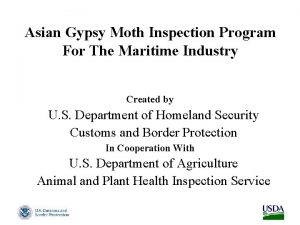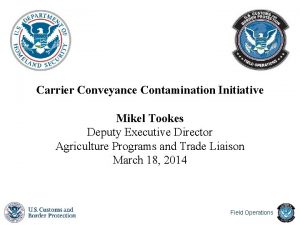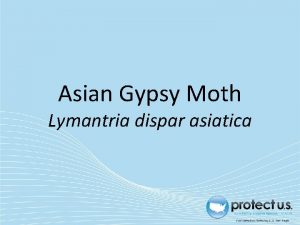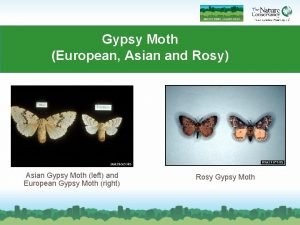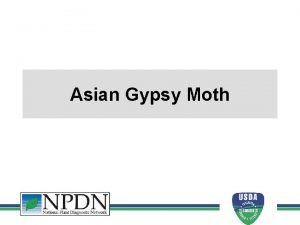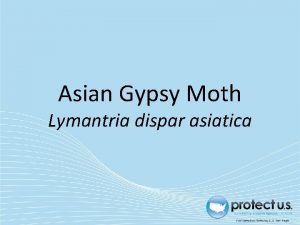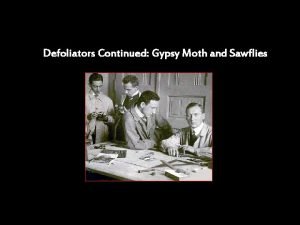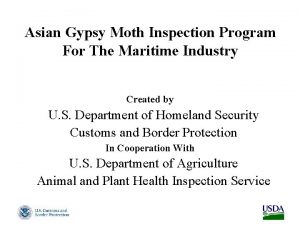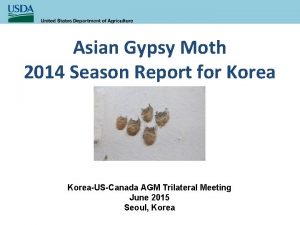Asian Gypsy Moth Asian Gypsy Moth Why is









- Slides: 9

Asian Gypsy Moth

Asian Gypsy Moth Why is it a problem? • Wide host range (500 species of trees and shrubs) – Larch, oak, poplar, alder, willow and some conifers including hemlock, pine, spruce and southern white cedar • All of the damage caused by Asian Gypsy Moth (AGM) is caused during the caterpillar stage. – If became established could cause defoliation of millions of acres of trees causing a huge economic impact. Additionally, large amounts of caterpillar frass, destroyed leaves and dead moths would be a nuisance to homes, yards and parks.

Asian Gypsy Moth Lymantria dispar • Native to Asia • Transported to N. A. by ships from Russia and Germany • First identified in British Columbia in 1991 • Not established in the U. S. but has been detected and eradicated from CA, OR, ID, TX and WA. Photo Ferenc Lakatos, University of West. Hungary, www. ipmimages. org

Comparing Gypsy Moth Pests • European Gypsy Moth (EGM) was intentionally introduced in the U. S. in 1869 and is now established in northeastern U. S. and southeastern Canada. • AGM like EGM prefers forest habitats and both cause defoliation and deterioration of trees and shrubs. • AGM has a broader host range than EGM. • AGM adult females are active fliers where EGM adult females are flightless. Greater ability to disperse. Asian Gypsy Moth on left and European Gypsy Moth on right. Photo USDA-APHISPPQ, www. ipmimages. org

Asian Gypsy Moth What does it look like? Male Larva or caterpillar Photos clockwise: AGM larva, Ferenc Lakatos, University of West-Hungary, AGM Adult Male, John Gent, USDA Forest Service, AGM Adult Female, John Gent, USDA Forest Service, www. ipmimages. org Female

Asian Gypsy Moth What does the damage look like? Photos left to right: Damage from AGM larva feeding, Defoliation from AGM larvae feedilng, Ferenc Lakatos, University of West-Hungary, www. ipmimages. org

Asian Gypsy Moth life Cycle Four Stages: Egg → Larva (caterpillar) → Pupae (cocoon) → and Moth AGM egg masses may be found on trees, stones, walls, logs and lawn furniture and other outdoor objects. Each 1 ½ inch egg mass contains 100 eggs. The mass is covered with a buff or yellowish fuzz which comes from the abdomen of the female. Photos left to right: Damage from AGM larva feeding, Ferenc Lakatos, University of West-Hungary, Egg mass, John H. Gent, USDA Forest Service, www. ipmimages. org AGM eggs begin hatching into caterpillars in the spring. All of the damage caused by the AGM is done during this stage.

Asian Gypsy Moth life Cycle AGM caterpillars stop feeding when they enter the pupal or cocoon stage. This begins in late June or July. Photo USDA-APHIS-PPQ, www. ipmimages. org Photo Ferenc Lakatos, University of West. Hungary, www. ipmimages. org Adults emarge from the cocoons in 10 to 14 days. AGM does not feed in the moth stage but only mate and lay eggs. Eggs are laid between July and September. The eggs remain dormant during the winter and hatch in the spring.

Asian Gypsy Moth Status and Control? • Considered a pest of regulatory concern. • Control should be simple if timing is perfect: – Bt is labeled and effective
